
World Day for Animals in Laboratories was founded in 1979. It has always held up a mirror to the state of the animal rights movement, especially the struggle against vivisection: the campaigns, the triumphs and defeats, the groups and people who fought so hard to stop the cruel, unscientific scourge of animal experimentation. This is an important story that needs to be told.
Here is a look at the history of the last four decades. Each of these entries orginally appeared separately over 40 days on the WDAIL Facebook page in the runup to this year’s protest in Oxford. Now they are collected here in “boxset” form. Part one covers 1979-1997. Part two, published tomorrow, will feature the past 20 years.
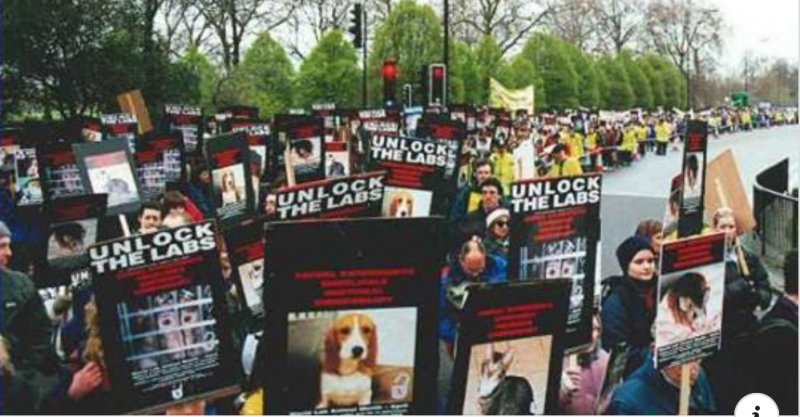
World Day at 40: 1979. The date 24 April was chosen by the National Anti-Vivisection Society as it was the birthday of former NAVS president Hugh Dowding. By the late 1970s vivisection was back to the top of the agenda for the first time in decades thanks to the rise in direct action and the Animal Liberation Front.
“In 1977 the ALF carried out 14 raids and liberated over 200 animals from laboratory suppliers. The hardest hitting ALF raid so far was carried out when activists broke into the Condiltox lab in North London and caused £80,000 damage. Soon afterwards the lab went out of business.” (Against All Odds: Animal Liberation 1972-1986 pg.6)
Over the next 40 days up to 24 April we will look at the last four decades of opposition to animal testing: the campaigns, the people, the scandals, the victories and defeats.
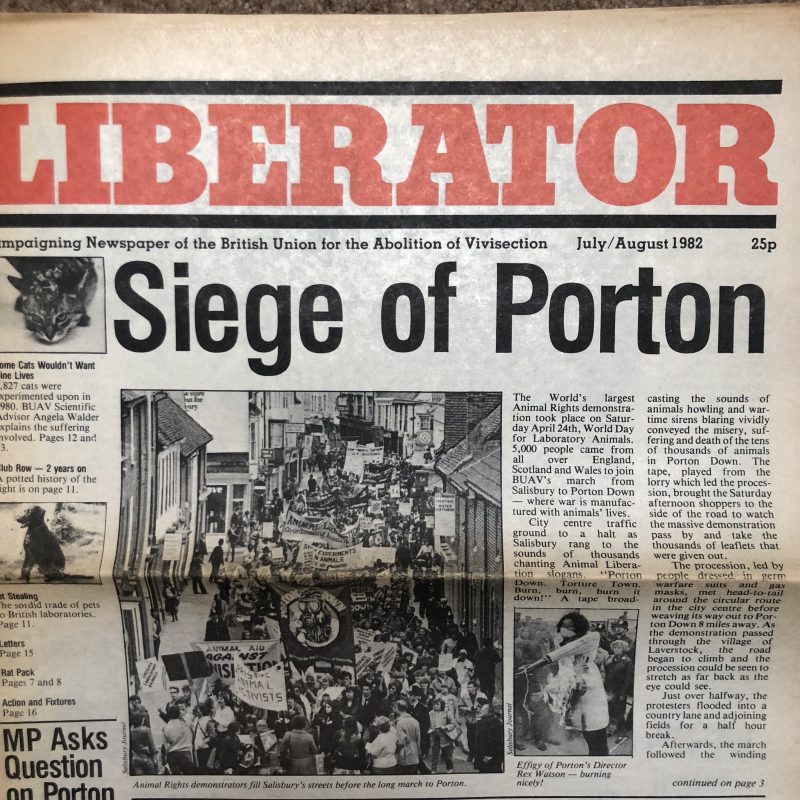
World Day at 40: 1982. 5,000 people walked eight miles from Salisbury to the Ministry of Defence weapons research base at Porton Down for the first march held on World Day.
Although WDAIL was founded in 1979, it was another three years before the first national protest on or near 24 April took place. 1982 was a turning point in animal rights militancy with 12 ALF raids and many more demos and actions, from pickets and sit-ins to daubing paint, gluing locks and breaking windows of laboratories.
The newly radicalised British Union for the Abolition of Vivisection was at the forefront of this upsurge – office manager Margaret Manzoni had been arrested for trying to liberate cats from Hillgrove Farm – and it organised the march to Porton Down.
According to its journal Liberator: “City centre traffic ground to a halt as Salisbury rang to the sounds of thousands chanting animal liberation slogans…A tape broadcasting the sounds of animals howling and wartime sirens blaring vividly conveyed the misery, suffering and death of thousands of animals in Porton Down”.
When the procession reached the lab, an effigy of the director was burnt and chants of “In! In! In!’ began. A crowd of over 1500 surged across the fence and onto MOD land. Scuffles broke out with police, a police dog handler was bitten by his own dog, and 29 arrests were made.
Twenty three activists pleaded guilty to trespass and were fined £20 each. A defence fund was set up and the BUAV said: “Many people feel that this demonstration was a significant step forward in the solidarity of the animal rights movement.”
Subsequent marches ended in battles between protesters and police as attempts were made to storm Huntingdon Research Centre and Bristol University in 1982 and BIBRA on World Day in 1983. After that it became clear such actions in broad daylight with police around were counterproductive.
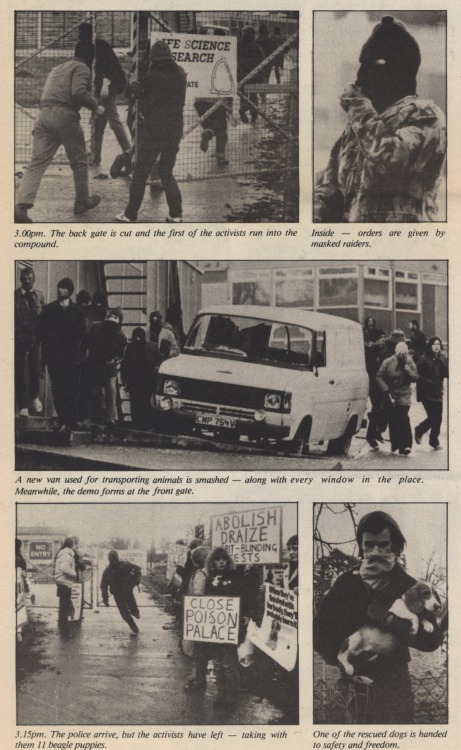
World Day at 40: 1982. Operation Valentine was an ALF raid on Life Science Research in Essex. Activists forced their way into the contract-testing laboratory in broad daylight, rescuing nine beagles and over 100 rats and mice.
Damage was estimated at £100,000 plus the almost total destruction of a van used to collect animals for vivisection. People fled in cars with the police in pursuit and there were 64 arrests but none of the animals were recovered.
The raid received huge publicity, including the front page of the Daily Mirror with the headline, “Rescued: hooded raiders free lab dogs”, alongside an iconic photo of a masked activist holding a beagle.
29 people were charged with conspiracy to cause criminal damage and steal. 17 were convicted in 1983, eight of whom were imprisoned for between 21 days and 15 months and a further nine were fined or ordered to do community service.
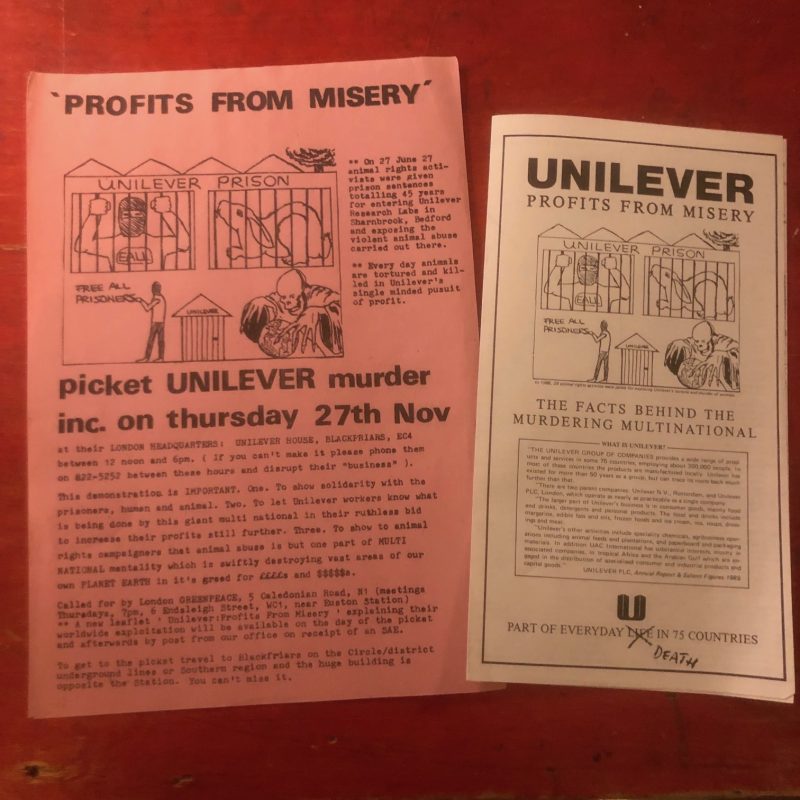
World Day at 40: 1984. Liberation Leagues were direct action organisations. Unlike the ALF which favoured clandestine activity and small groups of people, leagues consisted of coordinated daytime raids, or “invasions”, of animal labs by large numbers of activists.
in 1984 there were several high profile league raids. April saw the Northern Animal Liberation League storm ICI laboratories in Cheshire. Several people were arrested and two later went to prison.
In August the South East Animal Liberation League carried out a daylight raid on a research farm owned by the Royal College of Surgeons. As a result the British Union for the Abolition of Vivisection sued the RCS for causing unnecessary suffering to a macaque monkey called Mone.
Also in August 300 members of the Eastern Animal Liberation targeted Unilever’s research labs in Bedfordshire. While some picketed the main gate, others entered the buildings and removed files, caused £14,000 damage and rescued one guinea pig.
Twenty five people eventually received up to 30 months in gaol and this – together with the sentencing of seven SEALL members who raided Wickham Labs in October – led to the decline of the leagues by the late 1980s.
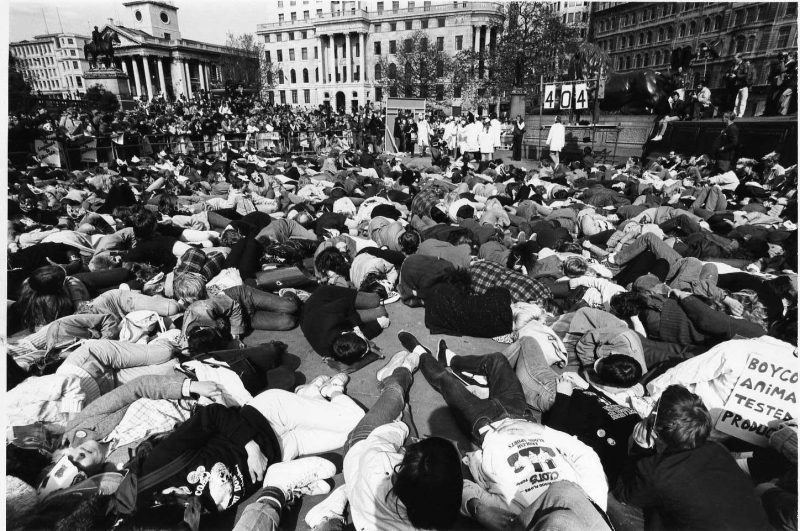
World Day at 40: 1984. The British Union for the Abolition of Vivisection’s protest in Trafalgar Square was the largest yet held. It was part of the Mobilisation for Laboratory Animals Coalition which included three other national societies: Animal Aid, the National Anti-Vivisection Society and the Scottish Society for the Prevention of Vivisection.
They joined forces because proposed new legislation “wouldn’t even ban particularly egregious examples of animal experimentation such as using animals for testing the negative effects of tobacco and alcohol, and the toxicity of cosmetics, as well as employing animals in research for military and psychological purposes.”
Mobilisation was controversial. Its critics said singling out certain experiments was tantamount to condoning others. They also condemned the cost of the campaign, about £250,000, at a time when direct action groups such as the ALF and liberation leagues were struggling. The new law was passed in 1986 with only 20 MPs voting against it.
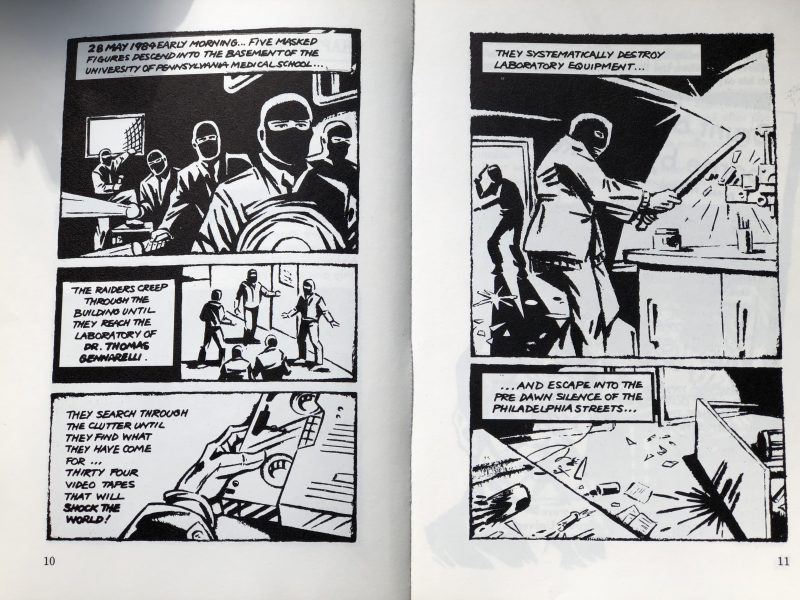
World Day at 40: 1984. The ALF raided University of Pennsylvania’s Head Injury Research Centre after receiving a tip off that horrific experiments were taking place on baboons. Thomas Genarelli had obtained thousands of dollars in grants from the National Institute of Health to simulate the kind of injuries humans receive in boxing bouts, football matches and car crashes.
Baboon’s heads were cemented with plaster of paris into metal helmets connected to a hydraulic device. The machine thrust the animal’s heads sharply upward at an angle of 60 degrees with a force of up to 1000g’s.
Video tapes removed by the ALF showed the experiments in progress. Copies were given to PETA who made an edited version called “Unnecessary Fuss”, from an interview Genarelli gave to a newspaper where he said he did not want to “stir up all sorts of unnecessary fuss among those who are sensitive to those types of things”.
The tapes were highly disturbing. Baboons so brain damaged they could no longer sit, stand or function were held up by vivisectors and ridiculed.
One researcher mocked a pathetic, injured baboon by saying, as if speaking to it: “You’re gonna rescue me from this, aren’t you?” Laughing members of staff were also seen posing with injured baboons.
Vivisectors smoked cigarettes while operating on the animals, dropped surgical tools on the floor and then placed them back in a baboon’s brain, and one of the them said: “We better hope the anti-vivisection people don’t get hold of this film.”
PETA showed the tape at a news conference and excerpts were seen on national tv, causing widespread revulsion. But instead of arresting Genarelli and his staff, police harassed activists and tried to catch the raiders.
In July 1985 over 100 people occupied the NIH building in Maryland. After four days they heard that the experiments had been stopped and no more baboons would suffer at the Head Injury lab. https://www.youtube.com/watch?v=PU-LK9TJ6-Q (Warning: graphic scenes of animal abuse).

World Day at 40: 1986. Hidden Crimes was produced by the American group called Suppress. Spokesperson Javier Burgos introduced it thus:
“You are about to see a revolutionary film. This film exposes not only the terrifying tortures which, disguised as science, are inflicted on millions of animals, but also the incalculable damage to human health that such scientific fraud is responsible for.”
Burgos and his supporters were “scientific anti-vivisectionists” who claimed the only way to end animal testing was by exposing it as “scientific fraud.” These campaigns had an almost religious zeal and accused animal rights groups of being naive, misguided or even, on occasion, infiltrated by the pharmaceutical industry.
Shocking footage recovered by the ALF and shown in Hidden Crimes nevertheless makes it one of the most powerful anti-vivisection statements ever.
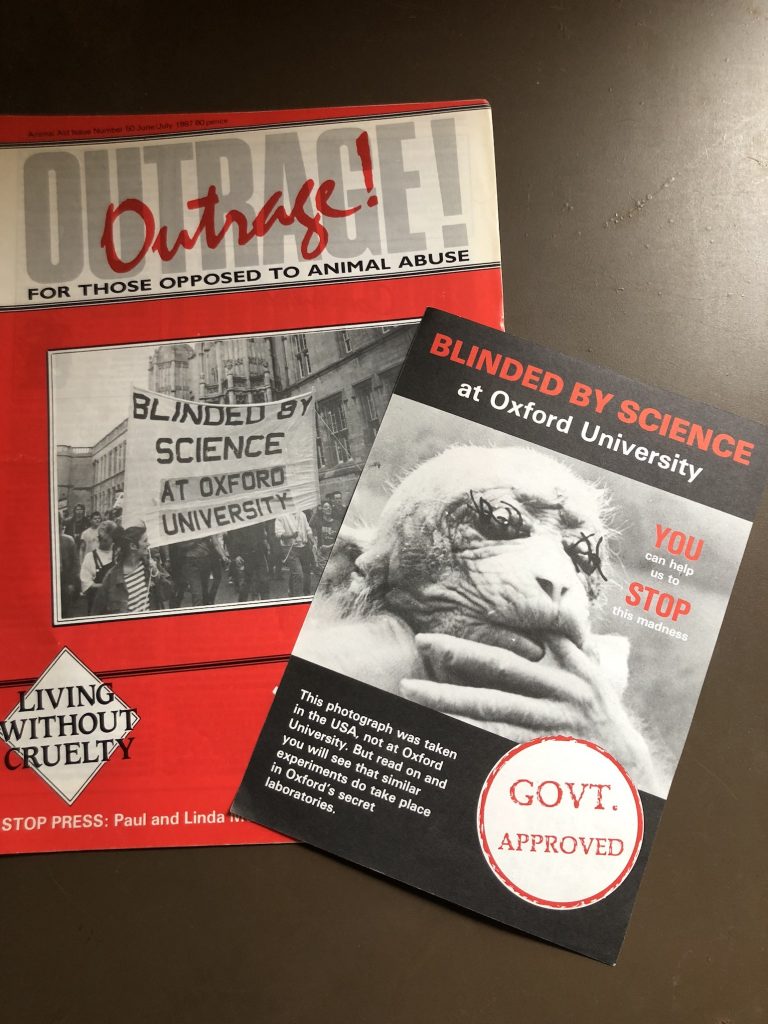
World Day at 40: 1987. This year’s WDAIL protest was in Oxford once more yet campaigns against the University go back decades. In 1987 Animal Aid’s Blinded By Science highlighted Colin Blakemore’s sight deprivation experiments “blinding cats and monkeys for about 20 years”.
Interest in vivisection at Oxford had been ignited by four liberation league raids which rescued over 50 cats and dogs and the University was accused of using ex-pets. The World Day protest on 25 April drew 3000 people.
Oxford Student Union passed a motion condemning Blakemore and others and the Sunday Mirror headlined with “Tortured in the name of science.” Blakemore remains a hate figure to this day.
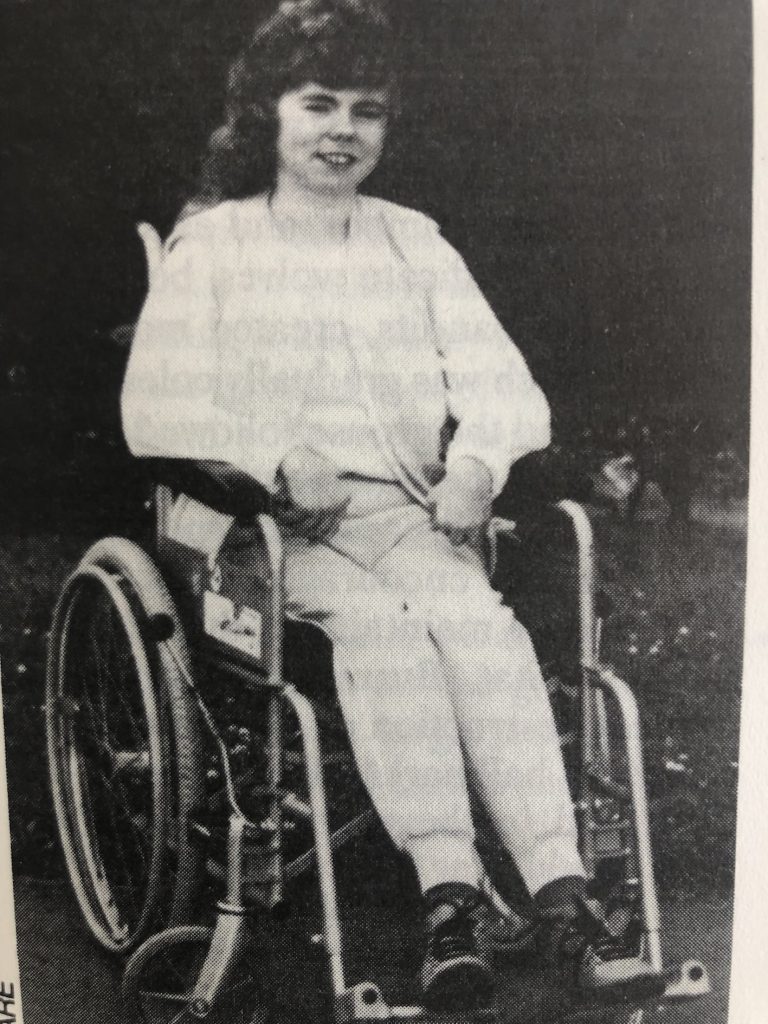
World Day at 40: 1988. Sue Crowshaw, founder of Disabled Against Animal Research & Exploitation, was interviewed in Turning Point magazine. She said:
“One day I noticed a massive advertisement in my home town. It depicted a girl in a wheelchair and the caption read, ‘you’re lucky you can walk away from this poster. Please give generously.’ This charity funded vivisection and all of a sudden I realised my image was being used to raise funds which would ultimately cause pain and suffering to millions of animals. I wanted no part of it.
Of course we need cures and to be free of pain but animal experiments are clearly not the answer. We must develop alternative research methods and practice preventative medicine. And for those of us who know our condition will not change, we must be allowed to accept this fact and our quality of life must be enhanced with better facilities and understanding.”
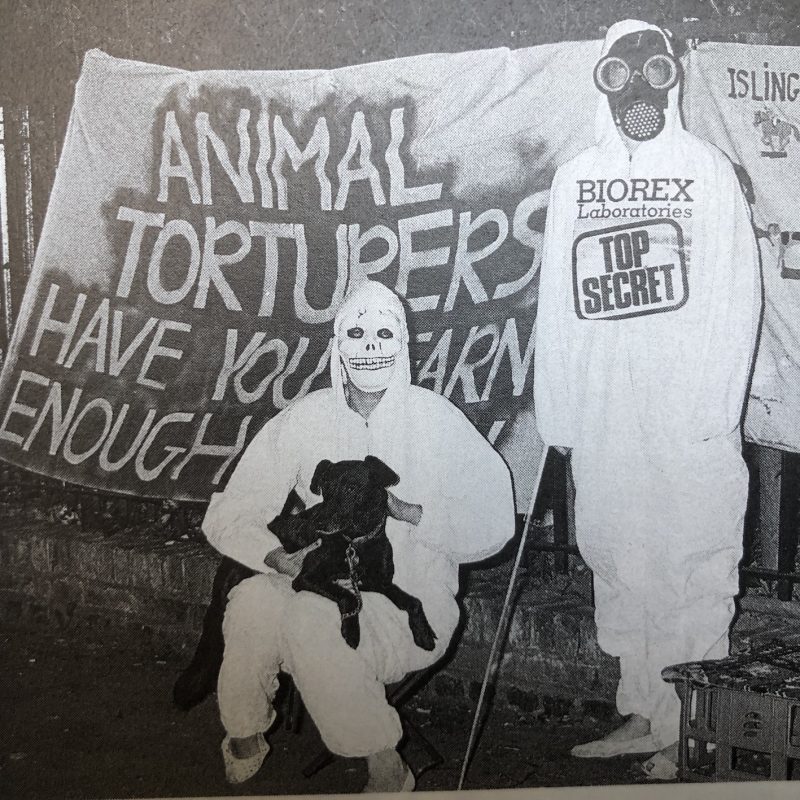
Biorex first came to public attention in 1982, when animal rights activists occupied its offices. A group of people then formed Islington Animal Rights Campaign (IARC) to campaign incessantly against their local lab. In 1983 IARC organised a national march in conjunction with the British Union for the Abolition of Vivisection. 2000 angry protesters marched past Biorex and a sit-down led to arrests.
The lab was kept under pressure with a series of demos and all night vigils. Anxiety showed on worker’s faces as they left the building and a special leaflet about Biorex was produced and delivered to every address in the borough. In addition it became a target for direct action with bricks through its windows, paintstripper poured on directors’ cars and slogans daubed on its walls.
In October 1988 a magazine reported one of the directors as saying the company had stopped using animals, insisting this was due to “company reasons and has nothing to do with anything else.”
A few months later half a dozen IARC members and a local journalist paid a visit to Biorex’s offices and politely asked if they could be shown around. The reaction was hysterical and police were called.
In an article in its newsletter entitled “Biorex – has the battle been won?” IARC said: “We would like to congratulate ourselves that all the years of pressure have had an effect but we have still received no proof.” Soon afterwards, however, there was proof: Greenpeace UK moved into the premises!
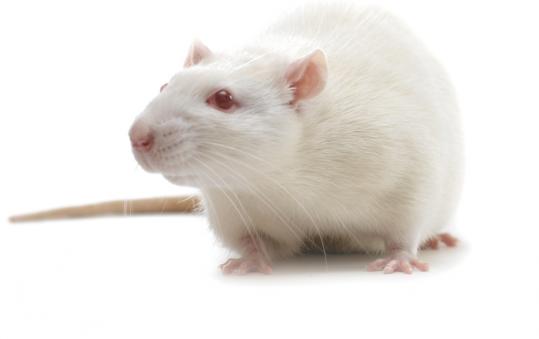
World Day at 40: 1989. Vivisector dies from his own experiment. Micheal Lewin had injected rats with cancer causing agents at London’s University College Hospital for 12 years.
One of the chemicals he used, Dimethylhydrazine, is highly poisonous if inhaled and so volatile it can be used as rocket fuel. Lewin became ill in June with diarrhoea and bleeding. He died in September and “the post mortem revealed multiple tumours, leading the coroner – who recorded death by misadventure – to say the link between the scientist’s death and his experiments was ‘inescapable'”.
Lewin should have been aware he was dealing with a potent human carcinogen yet the lab was so ill equipped that after at least 12 years of cancer research it did not even have a fume cupboard.
His fellow scientists defended him at the inquest, saying he always took precautions, yet if true this only makes the scenario all the more disturbing as clearly safety procedures were inadequate.
A newspaper reported: “Michael Lewin developed the same agonising symptoms as the rats he had been injecting with chemicals”. A true case of an animal abuser getting their comeuppance.
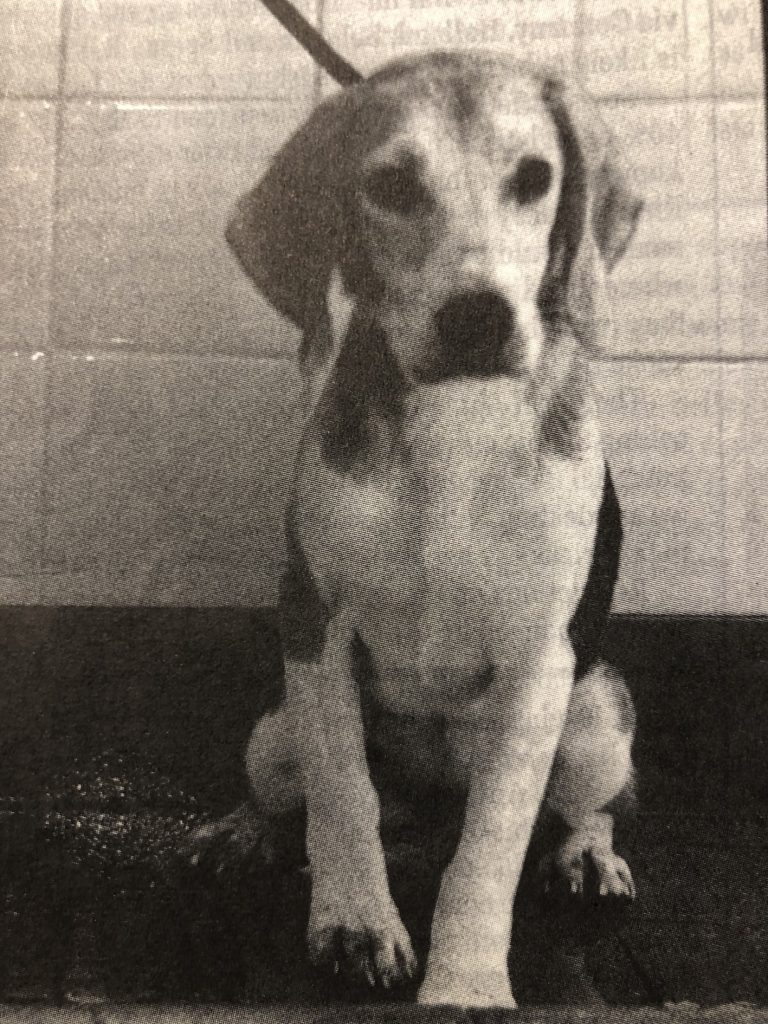
World Day at 40: 1989. A routine ferry journey for 100 beagles, destined for Astra pharmaceuticals in Sweden, became one of the biggest vivisection scandals of its age, exposing the trade in laboratory animals.
They were supplied by Perrycroft Kennels in Malvern, one of whose directors was on board the ferry and went to the upper deck with the driver to enjoy the journey in comfort.
Inside the poorly ventilated vehicle, the dogs began whimpering as they grew short of air. One passenger reported their crying but no action was taken. When the container was opened 79 beagles were dead.
The kennels became the focus of a national campaign, led by local activists along with Animal Aid. Protests and petitions called for the closure of Perrycroft and a public meeting was attended by many local residents.
Several ex-workers came forward with damning statements. One said their were no facilities for exercise and the ventilation system “never worked properly”. Another said: “The stench was so bad at times you could hardly breathe”.
The Ministry of Agriculture found Perrycroft had “failed in their duty of care” and they were fined £11,000 + £2,000 costs. In addition Astra said it would no longer use them.
The final blow was a council enforcement order to remove all dogs within six months due to a violation of planning laws. There were 70,000 offers of homes for the 400 remaining beagles when Perrycroft closed in 1991.
Animal Aid said the victory showed “how a combination of determined local and national campaigning can make life difficult for even well-established companies with vested interests in animal abuse”. Those lessons were learned by the Consort Beagles campaign five years later
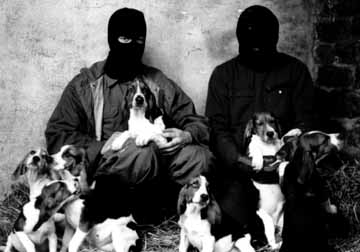
World Day at 40: 1990. The Interfauna raid of 16-17 March is one of the most famous Animal Liberation Front raids in history.
The ALF issued the following report: “On the evening of 16 March through to the early hours of the next morning, the ALF raided the premises of Interfauna, breeders of animals for vivisection, and liberated 82 beagle puppies and 26 New Zealand white rabbits.”
This wasn’t the first raid of the new decade. Thirty six dogs were taken from Oxford University’s Park Farm on 1 January. But Interfauna’s status as a target, the exceptionally large number of animals rescued and the high profile of the case, kick started the movement into a new phase of determination to attack the vivisection industry.
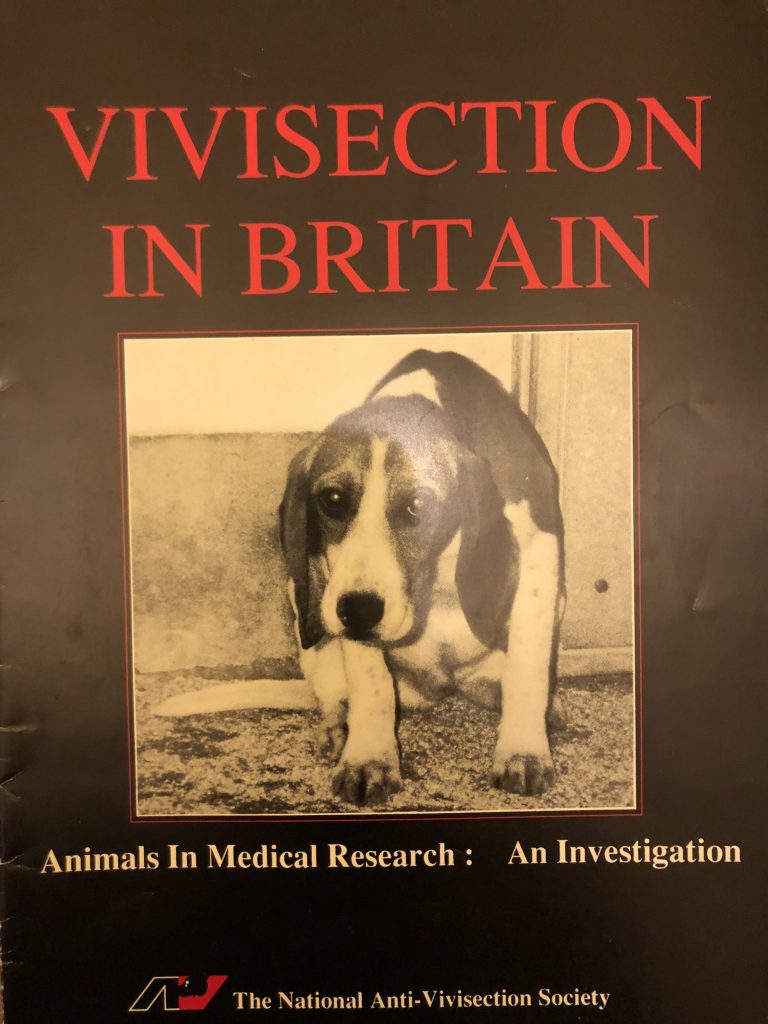
World Day at 40: 1991. Vivisection in Britain was a report published by the National Anti-Vivisection Society about an undercover investigation by Louise Wallis at SmithKline Beecham’s drug toxicity unit and St Barts Hospital medical research laboratories.
Louise witnessed “the force feeding of dogs and rodents with drugs, the crippling of rats and mice in arthritis and multiple sclerosis research and the irradiation of animals.” She kept an extensive diary and took photographs and video film.
Unlike earlier investigations, this one did not target areas of “unpopular” research or try to show laws were being broken in labs. On the contrary it was legal: “Even if the law worked perfectly, even if the Home Office inspectors and vets were thorough, the pointless misery would continue, that is just the point. As long as vivisection remains legal, suffering will go on.”
Louise and NAVS campaigned for the beagles she worked with to be freed but sadly they were all killed.
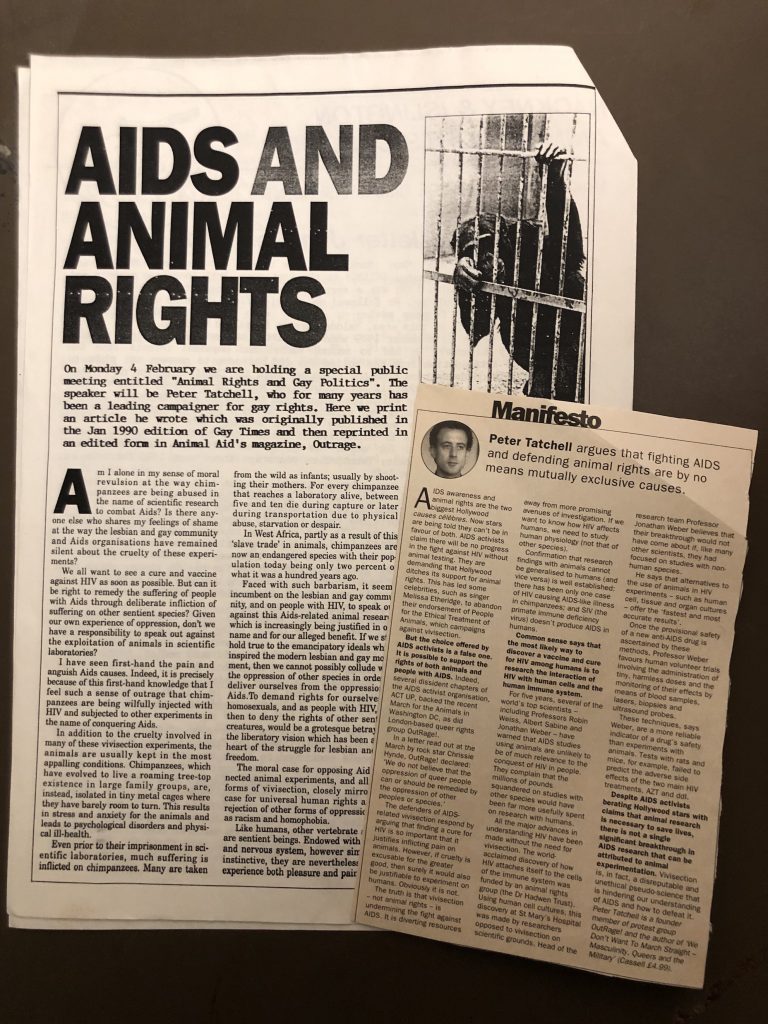
World Day at 40: 1991. Gay rights activist Peter Tatchell was invited to speak at a meeting organised by Hackney & Islington Animal Rights Campaign. The meeting focused on Tatchell’s opposition to AIDS research involving vivisection.
HIARC’s bulletin contained an article Tatchell had written for Gay Times, later reprinted in Animal Aid’s magazine, Outrage. In it he said: “Am I alone in my sense of moral revulsion at the chimpanzees are being abused in the name of scientific research to combat Aids.”
In a column entitled Manifesto in the magazine City Limits, Tatchell added: “Vivisection is, in fact, a disreputable and unethical pseudo-science that is hindering our understanding of AIDS and how to defeat it.” The meeting was very well attended and is an early example of intersectionalism in animal rights.
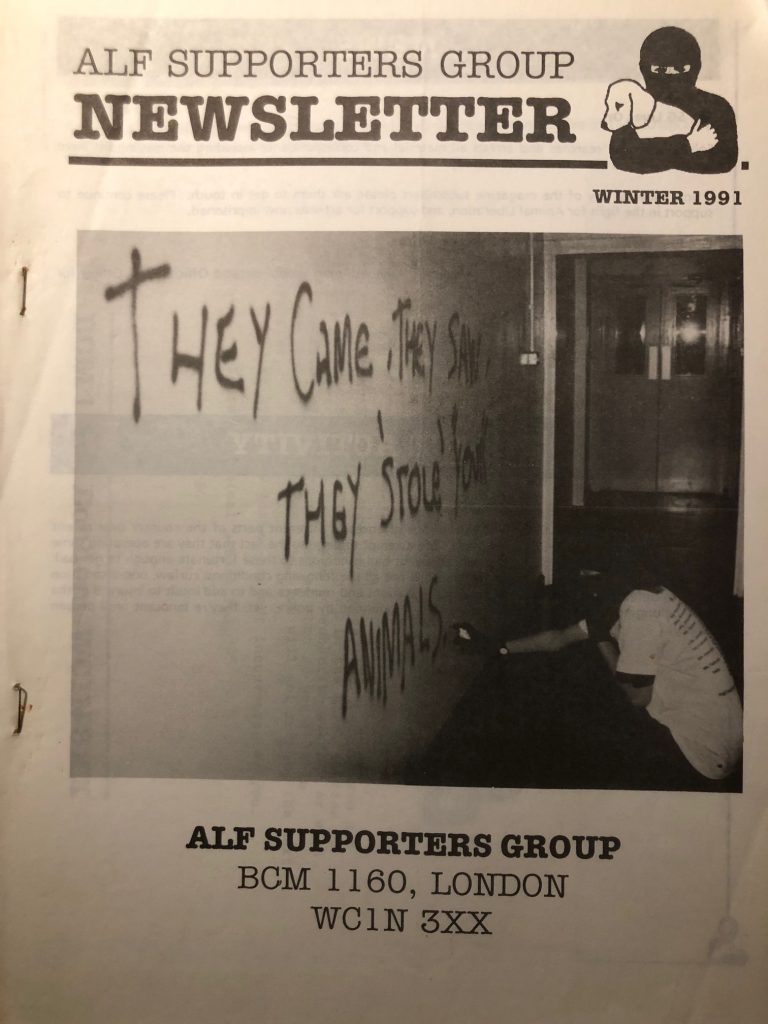
World Day at 40: 1991. This was the year of big raids. Hundreds of animals were rescued from Lancashire Polytechnic, Oxford University’s Park Farm, Surrey University’s Manor Farm and Cambridge University’s Laundry Farm – rats, mice, rabbits, cats, guinea pigs, dogs, polecats and even 43 doves!
But pride of place must go to London Hospital which, on 30 July, saw the most animals ever liberated by the ALF in a single action – 1400 mice and four beagles.
A vivisector who had tortured mice for 25 years burst into tears when she discovered the ALF had ruined her “research”. As a result the project was halted, saving thousands of future lives, at a cost of £2.5 million.
An undercover investigator named Adam Spare was infiltrating the hospital on behalf of the British Union for the Abolition of Vivisection. After the raid he was charged with conspiracy to burgle, criminal damage and theft of security cards. Activist Nancy Phipps supplied his reference and she too was charged in connection with the liberation.
Both went to trial in 1993 and the case against them quickly collapsed. Nancy wrote in the ALF Supporters Group Newsletter: “Our movement is winning. We are not criminals. It is up to all of us to fight in every way we know how, and whatever way we can, and to expose animal abuse for the evil it is. The criminals are the animal abusers.”
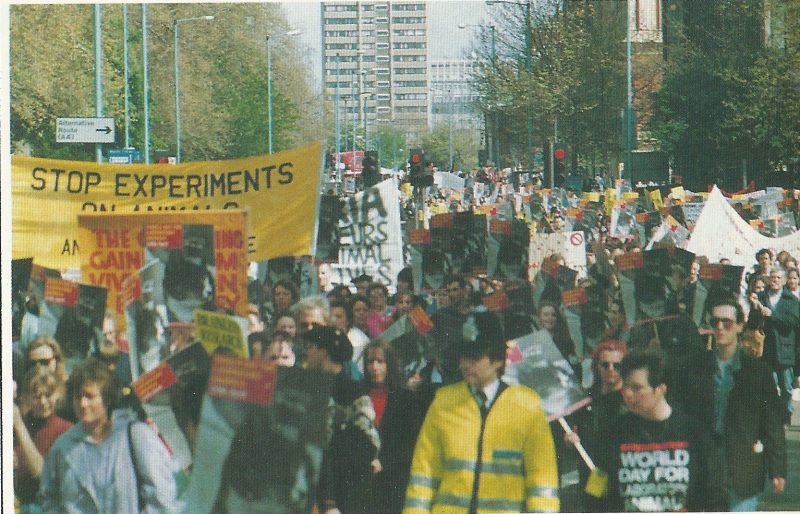
World Day at 40: 1992. The World Day for Laboratory Animals march in London remains the biggest anti-vivisection protest in history. The organiser, the National Anti-Vivisection Society (NAVS), said there were “in the region of 23,000 people.”
Over the previous 10 years there had been large marches against Porton Down in 1982 (5,000), BIBRA in 1983 (8,000) and a rally in Trafalgar Square in 1984 which drew 9,000. Participation declined after that but there were still respectable numbers in Cambridge, Oxford and Leeds.
From 1990-on NAVS decided to hold the event in London to maximise turnout. That year nearly 10,000 people marched from the Little Brown Dog statue in Battersea Park and this almost doubled to 18,000 in 1991.
The main reason for increasing numbers was vivisection had risen up the agenda again. The early nineties saw high-profile ALF raids on laboratories and breeders such as Interfauna, London Hospital, Boots, and Oxford, Cambridge and Surrey Universities.
As a result of the Boots raid, a campaign began against their chain of chemists with protests in towns and cities. It was reported that 60 of their shops were being attacked by the ALF each month.
1993’s World Day march was slightly smaller with 20,000 people and there was a sit down outside Boots along the route. This was condemned by NAVS who told “people who do not care about the future of the World Day march to organise their own events.”
That’s just what happened the next year as thousands went to primate supplier Shamrock Farm near Brighton. The turnout on NAVS’ march dipped to 15,000 and in 1995 it was dropped completely. After that World Day was taken over by grassroots campaigns
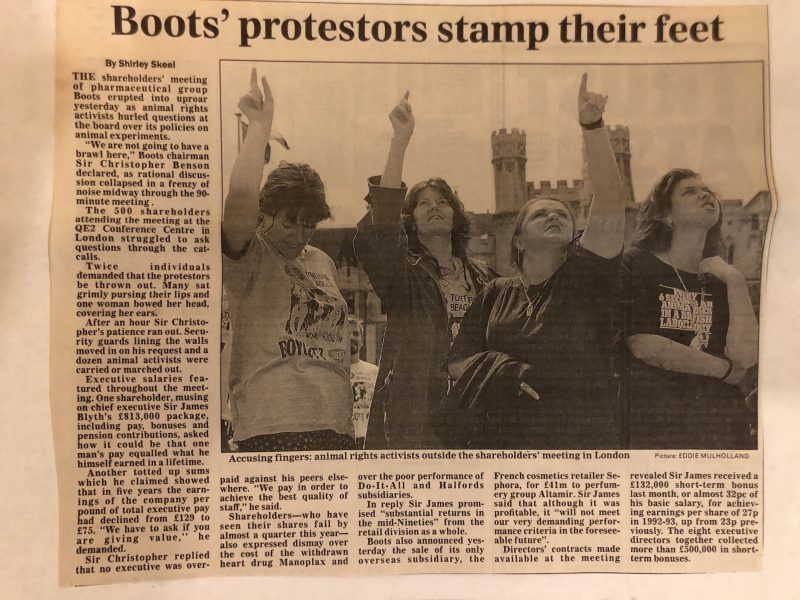
World Day at 40: 1993. Boots’ AGM was reduced to chaos as nearly 100 people demonstrated at the shareholders’ meeting in central London. Most protested outside but others had shares and gained entrance.
Chief executive James Blyth struggled to control proceedings and said “we are not going to have a brawl here” as activists hurled questions over Boots’ cruel animal experiments and shouted “you’ve got blood on your hands!” Eventually he called security and about a dozen people were carried or marched out kicking and screaming.
The board was also severely criticised over the heart drug Manoplax, which cost £100m to develop but had caused illness and death to patients. This and constant protests and direct action led to Boots closing down its laboratories in 1994, a huge victory for the animal rights movement.
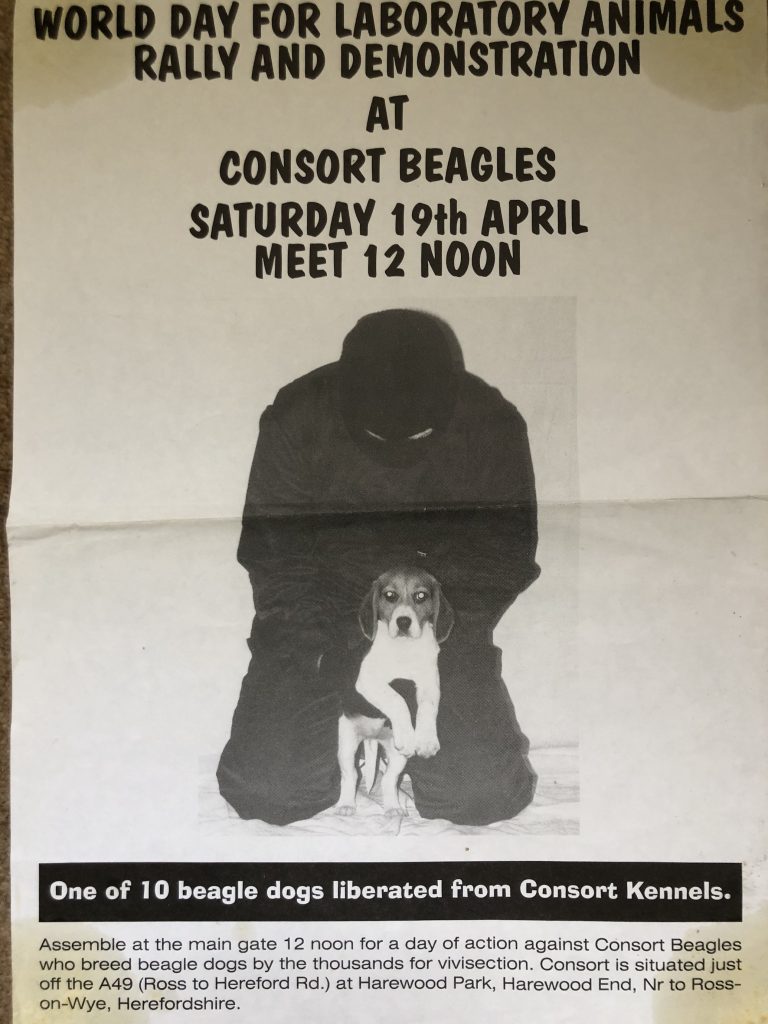
World Day at 40: 1997. Consort Beagles was a multi-million pound business near Ross-on-Wye that bred beagles for vivisection. 800 puppies were housed in huge wire mesh cages at any one time.
The Consort Beagle Campaign was founded by Greg Avery and Heather Nicholson in September 1996 with pickets at the gates, as workers went in and out, and all night vigils.
It entered the national spotlight when, during a protest in January 1997 to mark Barry Horne’s first hunger strike, activists broke into the kennels and rescued 10 puppies. 16 more were later liberated by the ALF.
Three months later Consort became the scene of one of the most famous World Day demos ever. 500 activists converged on the site and a riot ensued during which police were pelted with projectiles and riot cops overwhelmed as people tore down the razor wire fence. Protesters were sprayed with CS gas but some managed to get inside and free one beagle.
Another national demo took place a few weeks on and this together with attacks on the homes of directors led to Consort’s demise after just 10 months of campaigning. About 200 beagles went to loving homes.
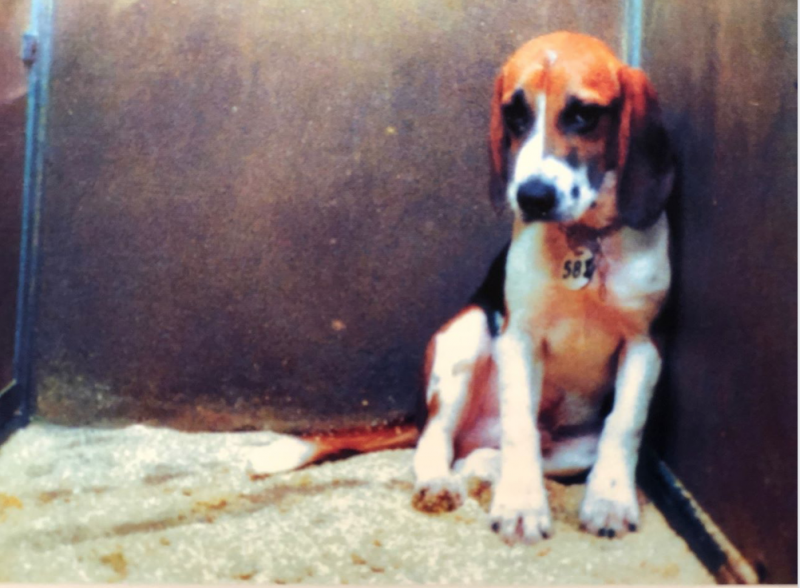
World Day at 40 1997: Zoe Broughton spent 10 weeks secretly filming at Huntingdon Life Sciences for a Channel 4 programme called Countryside Uncovered: It’s a Dog’s Life.
Zoe was placed in the beagle unit where dogs were kept in concrete pens without bedding. If puppies struggled while being injected they were hit or shaken by the scruff of their necks. Workers swore at and punched beagles in the face. Home Office inspectors visited HLS several times but never bothered to inspect the unit.
When her film was broadcast it caused outrage. The Labour government suspended HLS’ licence to vivisect and two workers were convicted of animal cruelty. They received 60 hours community service plus £250 costs. HLS’ licence was then reinstated after it promised to clean up its act.
Several more infiltrations of HLS occurred but Labour stood by the company to prevent it going out of business and instead persecuted campaigners.
Afterwards Zoe said she could not “forget the sound of the high pitched squealing of the dogs and I live with the fact that I never said anything then to stop what I saw, focusing only on getting the video footage out to the public to reveal what really goes on inside an animal testing laboratory”.
https://www.youtube.com/watch?v=zIwoFnXheq8 (warning: graphic scenes of animal abuse)
Leave a Reply